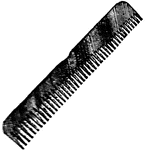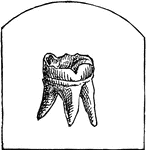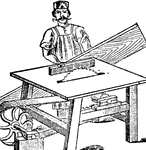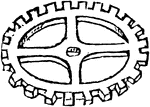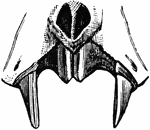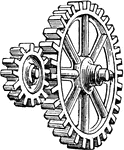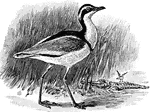
Grayling
"The Grayling is a genus of fresh-water fishes in the salmon family, distinguished from trout, etc.,…
!["A Tooth is one of the hard bodies of the mouth, attached to the skeleton, but not forming part of it and developed from the dermis or true skin. True teeth consist of one, two, or more tissues differing in their chemical composition and in their microscopical appearances. Dentine, which forms the body of the tooth, and 'cement,' which forms its outer crust, are always present, the third tissue, the 'enamel,' when present, being situated between the dentine and cement. The incisors, or cutting teeth, are situated in front. In men there are two of these incisors in each side of each jaw. The permanent incisors, molars, and premolars are preceded by a set of deciduous or milk teeth, which are lost before maturity, and replaced by the permanent ones. The canines come next to the incisors. In man there is one canine tooth in each half-jaw. The premolars (known also as bicuspids and false molars) come next in order to the canines. In man there are two premolars in each half-jaw. The true molars (or multicuspids) are placed most posteriorly. In man there are three molars in each half-jaw, the posterior one being termed the wisdom tooth. The figures [in the illustration] refer to months after birth."—(Charles Leonard-Stuart, 1911)](https://etc.usf.edu/clipart/15200/15256/teeth1_15256_mth.gif)
First Teeth
"A Tooth is one of the hard bodies of the mouth, attached to the skeleton, but not forming part of it…
!["A Tooth is one of the hard bodies of the mouth, attached to the skeleton, but not forming part of it and developed from the dermis or true skin. True teeth consist of one, two, or more tissues differing in their chemical composition and in their microscopical appearances. Dentine, which forms the body of the tooth, and 'cement,' which forms its outer crust, are always present, the third tissue, the 'enamel,' when present, being situated between the dentine and cement. The incisors, or cutting teeth, are situated in front. In men there are two of these incisors in each side of each jaw. The permanent incisors, molars, and premolars are preceded by a set of deciduous or milk teeth, which are lost before maturity, and replaced by the permanent ones. The canines come next to the incisors. In man there is one canine tooth in each half-jaw. The premolars (known also as bicuspids and false molars) come next in order to the canines. In man there are two premolars in each half-jaw. The true molars (or multicuspids) are placed most posteriorly. In man there are three molars in each half-jaw, the posterior one being termed the wisdom tooth. The figures [in the illustration] refer to years after birth."—(Charles Leonard-Stuart, 1911)](https://etc.usf.edu/clipart/15200/15257/teeth2_15257_mth.gif)
Second Teeth
"A Tooth is one of the hard bodies of the mouth, attached to the skeleton, but not forming part of it…

Wart Hog
"The Wart Hog closely resembles the true hogs in most of their characters, and particularly in their…

Whale
"Whale is a name that may be taken as equivalent to Cetacean, and applied to any member of that order…

Human skeleton
"There are in all two hundred and six seperate bones in the adult skelton. The teeth are not bones,…
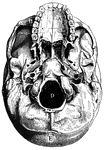
Base of skull
"A, Palate process of upper jawbone; B, zygoma, forming zygomatic arch; C, condyle, for forming articulation…
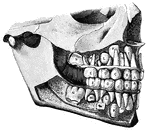
Temporary and permanent teeth
"Temporary Teeth: A, central incisors; B, lateral incisors; C, canines;…

Hyrax
"Hyrax is a genus of pachydermatous mammalia, intermediate in their character between the rhinoceros…

Lizard
"Lizard is the popular name of numerous reptiles having usually two pairs of limbs and an elongated…
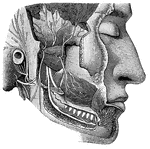
Cranial Nerves
"Dental Branch of One of the Divisions of the Fifth Pair of Cranial Nerves, supplying the Lower Teeth.…
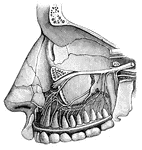
Cranial Nerves
"Dental Branches of One of the Divisions of the Fifth Pair of Cranial Nerves, supply the Upper Teeth."…
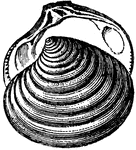
Astarte sulcata
"Astarte sulcata; In some systems of zoological classification, a family of dimyarian bi-valves, an…

Mandrill
"The Mandrill is an African baboon. It was well known to the ancients. A full grown male measures about…
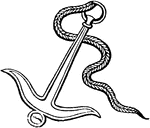
Ancora
"An Anchor. The anchor used by the ancients was for the most part made of iron, and its form resembled…
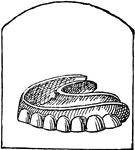
Teeth
The series of small bones attached to the jaws of animals, or human beings, which serve the purpose…

Ratchet
A bar or piece of mechanism turning at one end upon a pivot, while the other end falls into the teeth…

Cog Wheel
A wheel having teeth or cogs, used in ransmitting motion by enguaging the cogs of another similiar wheel…

Palaeotherium magnum
"The Palaeotherium magnum was of the size of a horse, but thicker and more clumsy; its head…

Savart wheel
"The Savart wheel consists of a heavy metal toothed wheel that may be put in rapid revolution by pulling…
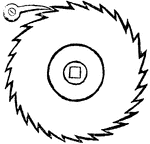
Ratchet-wheel
"A circular wheel, with teeth on the circumference, by which it can be moved or its motion stayed."…
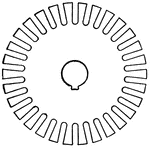
Solid core disk
"The metal cut away near the center reduces the weight and provides passages for air circulation." —…
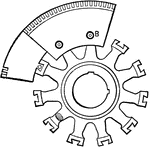
Armature core
"Side view of built up armature core. The sheet metal ring sections containing the teeth are fastened…
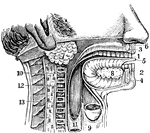
Mouth and Neck
The mouth and neck laid open. 1: The teeth. 3 and 4: Upper and lower jaws. 5: The tongue. 7: Parotid…
Reciprocal Saw-Teeth
This design is sometimes call by the Persians "sechrudisih," meaning teeth of the rat. Almost distinctive…
Pike
A genus of fishes found in the freshwater bodies of America and Eurasia. Most species have a long body…

Carnivorous Skeleton
The teeth of a carnivorous animal that lives on flesh alone. The front teeth are tearing ones, while…

Crown Wheel
A wheel having cogs or teeth set at right angles with its plane. Commonly used in watches.

Shark
An extensive genus of fishes of the ray family, found widely distributed in the ocean, but most abundantly…

Teeth
The hard, bony structures situated in the mouth or near the entrance to the pharynx of vertebrates,…

Funaria
This illustration shows the structure of capsule of Funaria: 5, capsule with calyptra, 5A, removed.…

Cunner
The blue perch. Up to 12 inches in length and having about 18 dorsal spines, conical teeth in several…

Dab
The teeth are compressed and trunctated, and the lateral line is cimple and arched above the pectoral.

Sauropus Primaevus
Amphibian Reptiles occur through the age. They are called Labyrinthodonts, because the teeth, like those…

Iguanodon
An extinct fossil colossal lizard found in the Wealden strata; so called from the resemblance of its…
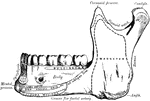
Mandible
The mandible is the largest and strongest bone of the face. It serves for the reception of the lower…
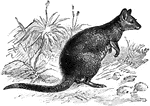
Papuan Kangaroo
They are small size and somber coloration, with the hair on the nape antrorse, the tail naked and scaly…

Bivalve Mollusk
"Shell of a Bivalve Mollusk, inner surface. ad.a., depression showing the attachment of the anterior…

Pike Perch
A fish with elongated form, subconical head, and sharp canines mixed with the villiform teeth from the…
Gangetic Dolphin
A dolphin with about 120 teeth, 50 vertebrae, extremely narrow jaw, no pelvic bone, rudimentary eyes,…

Ventral Valve
"Waldheimia flavescens. Interior of ventral valve. f, foramen; d, deltidium; t, teeth; a, adductor impressions;…

Harrison's Going-Ratchet
"The click barrel-ratchet R is set upon another larger ratchet-wheel, with its teeth pointing the opposite…

Gravity Train Remontoire
"E represents the scape-wheel turning in a minute, and e its pinion, which is driven by the wheel D…
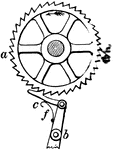
Ratchet Wheel
A wheel with pointed and anglar teeth, against which a ratchet abuts, used either for converting a reciprocating…

Horse Skull
"Side view of skull of horse, with the bone removed so as to expose the whole of the teeth. PMx, premaxilla;…

